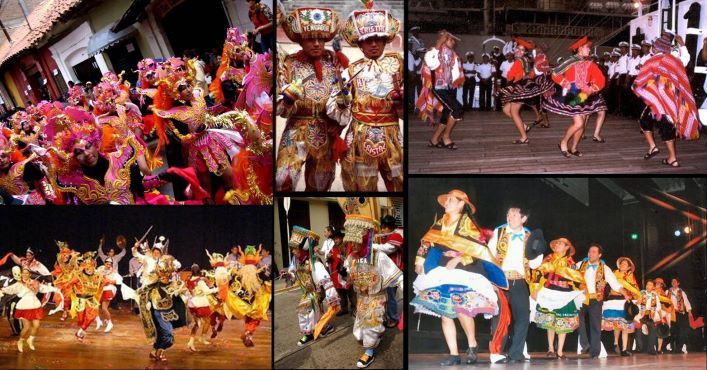Perhaps you have read somewhere that more than 3,000 traditional Peruvian festivities are held annually? They are part of the folklore that is usually published in travel guides or on the internet. Certainly, the volume of information about popular festivals in Peru is immense, this is a fact! Peru is a country that maintains its ancient traditions, while embracing more and more novelties, becoming a rain where festivals and festivals of all kinds flourish.
If you plan to visit Peru, you may be impressed by the chance to observe or even participate in one of these different Peruvian festivals. In this case, you are in luck! Below are some of our favorite Peruvian festivals. We list one for each month of the year, so it will be easier to reconcile it with your travel dates.
Remember this is only the tip of the iceberg. All of these Peruvian fiestas are fantastic, but there is so much more that we had to put aside simply because of the sheer number of festivities and holidays. If we don’t include any options that match your travel itinerary, don’t worry! Do some research because we are sure you will find a festival for you.
Without further ado, let’s go!
January – Fiesta de la Marinera de Trujillo


Trujillo, a beach town located in northern Peru. It is the traditional place of the sailor, an elegant dance for couples that uses scarves as props. Since 1986, Trujillo is the official national capital of this dance. This holiday is celebrated annually in this month-long maritime festival that involves the entire city! The Marinera Festival, as it is known in Spanish, or Festa do Marinheiro in Portuguese, features dance competitions, parades and even exhibitions of the Paso Peruano, a breed of horses also recognized as part of the cultural heritage of the Trujillo region. One of our favorite Peruvian festivals. Do not miss the opportunity to find out if you are here during the month of January.
February – Candelária Festival
The Candelaria Festival is not only the largest and most famous festival in Peru, but also one of the largest in South America in general. In fact, considering the entire continent, it is only overshadowed by the world famous Rio de Janeiro Carnival or the Golden Carnival in Bolivia. The first of many Peruvian religious festivals on our list, the Festa da Candelária celebrates the Virgin of Candelária, the patron saint of the city of Puno, where it is celebrated. Music and dance are the main attractions of this festival. Participants wear costumes specially designed for the festival. An incredible syncretism of indigenous and Catholic traditions that unfolds over two weeks. This is one of the most emblematic festivals in Peru.
March – International Harvest Festival
Depending on the date on which Holy Week is celebrated during a given year, the month of March can be very intense or very quiet in relation to the main Peruvian holidays. Taking into account the variations of this date, we thought that we could also take a break from religious festivals to focus on another type of attraction, wine! The Peruvian region of Ica is famous for many reasons. The Nazca Lines and the Huacachinas Oasis are two of its main destinations. In addition, experts also recognize it as the best wine region in the country. This celebration has been held annually in March since the 1950s, during the International Harvest Festival or International Harvest Festival, in which a queen is chosen to ceremoniously step on the first grapes harvested of the season.
April – HOLY MONDAY- Procession of the Lord of Cuzco Earthquakes
El Señor de los Temblores (or Señor de los Tremblores) is a sworn defender of the city of Cuzco and the main celebration of Holy Week in the city. The story goes that during an earthquake in Cuzco in 1650, an image of Jesus Christ like a painting was drawn in the sky while prayers were offered, which caused the earthquakes to subside and saved the city from destruction. Since then, the high image has become the focal point of this important annual celebration. Every Easter Monday, at 7 in the afternoon, the image arrives at the Cathedral of Cuzco after offering the blessing to the Cuzco people. Surprisingly, it is said that the image was not originally black, but that its color is due to years of exposure to incense smoke during religious ceremonies.
May – Feast of the Crosses – CRUZ VELAKUY
Let’s clarify first: the Festa das Cruzes or the Festival das Cruzes is not an exclusively Peruvian party. Despite this, the way Peruvians celebrate has made it one of the most important festivals in Peru. You may notice that the Fiesta de las Cruces is not celebrated in one place in the country. Rather, the festival is celebrated in Peruvian towns and cities, each adding its own unique twist to the celebration. Festivals across the country include music, dance, and even events like bullfights as part of the celebrations.
June – Inti Raymi – Sun Festival
The Inti Raymi, the old Inca do Sol Festival, is one of the most traditional Peruvian festivals on our list. With indigenous characteristics, it did not suffer Catholic influence. Held annually on June 24, Inti Raymi is intended to celebrate the winter solstice. Remembering that the city of Cuzco is located in the southern hemisphere! Banned by the Spanish and Catholic Church as of 1535, the modern staging of the celebration resumed in 1944, based on the few historical records of the festivities that managed to stay alive. Since then it has grown in size and purpose, where its historical and cultural importance is unique, moving thousands of people. Among all the suggested festivals, the Festa do Sol stands out and is worth visiting.
July – Feast of the Virgen del Carmen
A good example of traditional Andean culture mixed with Catholicism is the Fiesta de la Virgen del Carmen. It is held annually around July 16 in the relatively small city of PAUCARTAMBO, four hours from Cuzco. This three or four day festival seems to have a religious character, but it is also one of the biggest and wildest festivals in Peru. It draws visitors from all over the country, causing many to spend the night sleeping under the stars, as there simply isn’t enough space in the city to accommodate so many people. If you know a little about this topic, you will notice a close relationship with the Peruvian history represented in the music, costumes and dances of the festival. For example, dancers in black masks represent African slaves brought to work in the silver mines during colonial times.
August – Saint Rose of Lima Day
Santa Rosa de Lima was the first Peruvian saint canonized by the Catholic Church and her legacy is celebrated throughout the world. However, don’t be surprised if the biggest festivals take place in your home country – Peru. On August 30, the anniversary of her death, celebrations and memorials are held throughout the country, being DEFENDER OF THE NATIONAL POLICE OF PERU.
September – Culinary Festival of Mistura
As you already know, Peruvian cuisine is one of the best in the world! Lima, in particular, certainly presents the most impressive gastronomic panorama in South America, if the food alone is not attractive enough for you, in September the experience of eating in Peru becomes even more attractive. That’s when the Mistura Culinary Festival arrives. With more than 200 restaurants and bars, not to mention the street vendors and food carts, more than half a million visitors stop to enjoy the festival’s offerings for ten days in mid-September. Although it is not one of the most traditional festivals on our list, it is without a doubt the most delicious of all.
October – Procession of the Lord of Miracles and Warachicuy Ceremony
The story may seem a bit familiar, an 18th century earthquake destroyed much of the city, leaving only that iconic image of Jesus Christ standing. The event was considered a miracle, the image became even more revered and, over time, the celebration of its party became the largest religious festival in Peru. It has one of the longest religious processions in the world. If you just want to have fun, this party is probably not for you. However, this solemn celebration is one of the most important Peruvian festivals and we cannot leave it off our list.
WARACHICUY – CUSCO
This ancient Inca tradition takes place in the ruins of Sacsayhuaman. Involving hundreds of young students at the Glorious National College of Sciences – Cuzco. They wear very colorful clothes and show their great athletic ability to pass the tests that allow them to transition to adulthood.
November – All Saints’ Day
All Saints’ Day is celebrated throughout Peru on November 1 and 2. Honor both the saints and the dead Peruvians. The event features masses, prayers, flowers, cakes, sweets and a candle lit until dawn. On these dates, Peruvians will visit their dead in local cemeteries.
December – Santuranticuy
When we finish our list, some things should already be clear: the first is that Peruvians love their parties. The second is that many of these Peruvian holidays have religious and Catholic themes. The last party on our list, of course, is no different: Santuranticuy is celebrated exclusively in the city of Cuzco every year on Christmas Eve, December 24th. It is essentially a huge outdoor market created to celebrate Christmas. The name of the festival, which means “sale of saints”, is quite appropriate, since the main ones here are sculptures and figures used to decorate Catholic nativity scenes, which are found in many Peruvian homes during Christmas. However, even if you are not religious, you will surely find something of interest in this most attractive Peruvian festival for tourists.










